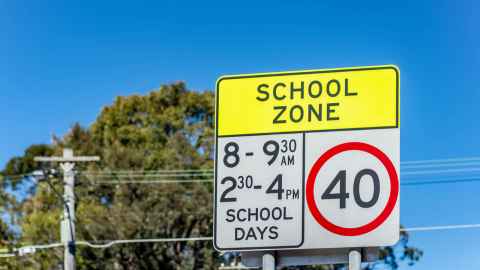Convenience never trumps the lives of children
19 March 2024
Opinion: Blanket speed limits might inconvenience some drivers, but we know for sure they save the lives of children, says Tim Welch.

In a move that has shocked road safety advocates across the country, the new Minister of Transport, Simeon Brown, is poised to abandon the previous government’s speed limit reduction policy, particularly around schools.
Even more alarmingly, he wants school speed limits to be variable rather than full-time, arguing that blanket reductions inconvenience drivers. This stance, coupled with the Government’s recent opposition to raised pedestrian crossings and other walking and cycling improvements, represents a dangerous step backward for road safety in New Zealand, especially for our most vulnerable road users – our children.
Slower speeds saving lives isn’t a political position nor an opinion. For decades, we’ve had clear evidence that higher road speeds lead to a greater likelihood of severe injuries and death – it’s a subject nearly everyone understands. Even small increases in speed lead to much higher risks of severe injury or death for pedestrians. At just 26kph, people are already more likely to be seriously hurt if hit. When cars reach 37kph, the chance of a fatal outcome increases significantly.
Evidence from Healthy Auckland Together showing that if a car hits a vulnerable road user, such as a young child, at 60kph, there is no chance of survival. This speed is common on a road with a 50kph limit.
Even more troubling is evidence from Healthy Auckland Together showing that if a car hits a vulnerable road user, such as a young child, at 60kph, there is no chance of survival. This speed is common on a road with a 50kph limit. The solution is simple: lower the speed to 30kph, and the chance of survival jumps to 90 percent.
In 2021, five-year-old Joanna Kong was killed by a car outside her Auckland school, Pigeon Mountain Primary, where the speed limit was 50kph. In 2019, two schoolchildren were seriously injured after being hit on a pedestrian crossing just a few hundred metres from Kōwhai Intermediate. In February 2023, a child was critically injured when he was hit by a car on Auckland’s North Shore less than 200m from three schools, just two weeks after another child was struck and seriously injured on their way home from school in Browns Bay.
Implementing full-time speed reductions around schools could prevent more families from enduring such devastating losses and ensure children have a safer journey to and from their places of learning.
Brown claims that blanket speed limits inconvenience drivers, but the impact on travel times is minimal when weighed against the potential to save lives. Auckland Transport argues that the speed reductions in the Katoa, Ka Ora Programme will, on average, add less than 15 seconds to a 20-minute car trip. A child’s life is worth far more than a few seconds of our time.
Variable speed limits that only apply during school hours create confusion and inconsistency for drivers. They fail to protect children who travel to school early, leave late, or use school grounds on weekends. As Palmerston North City Council discovered when considering its options, implementing variable limits is also more expensive because of the need for electronic signage, which can cost more than $2.4 million. In contrast, full-time speed reductions are more straightforward to implement, more cost-effective, and ultimately more successful in creating a safer environment for children.
Raised pedestrian crossings are another critical aspect of safer school zones that should not be overlooked. A comprehensive study conducted by Waka Kotahi found that raised crossings have the potential to reduce deaths and serious injuries by up to 40 percent. Data from Auckland Transport further supports these findings, showing that crashes fell from 20.8 to 5.6 per year at upgraded crossings, with serious injuries dropping from 10 to just one annually.
The elevated design of these crossings makes them more visible to drivers, encouraging increased awareness and making drivers more likely to yield to pedestrians. They are especially beneficial near schools, where children are more likely to cross roads and may be less aware of their surroundings or the dangers posed by oncoming traffic.
Evidence tells us that higher speeds lead to more crashes and more severe injuries – all of which come at a high cost. Though we shouldn’t have to put a price tag on a child’s life, road deaths and injuries already have a social cost of $9.7 billion every year since 2021.
Full-time speed limits and raised crossings near schools aren’t just smart investments in keeping kids safe; they’re critical steps towards preventing tragedies and easing the massive economic toll unsafe roads take on all New Zealanders.
As a society, we must protect our most vulnerable road users, especially our children, who trust us to make choices that keep them safe. By ditching proven safety measures to save drivers a few minutes, Simeon Brown’s views on speed, raised crossings and active mode infrastructure investments send a clear message that convenience trumps kids’ lives.
The power to save young lives and prevent the unimaginable pain of losing a child is in our hands. Listen to the overwhelming evidence and make the safety of our tamariki a top priority.
Dr Timothy F Welch is a Senior Lecturer in the School of Architecture and Planning at the University of Auckland’s Faculty of Creative Arts and Industries.
This article reflects the opinion of the author and not necessarily the views of Waipapa Taumata Rau University of Auckland.
This article was first published on Newsroom, Convenience never trumps the lives of children, 19 March, 2024
Media contact
Margo White I Research communications editor
Mob 021 926 408
Email margo.white@auckland.ac.nz